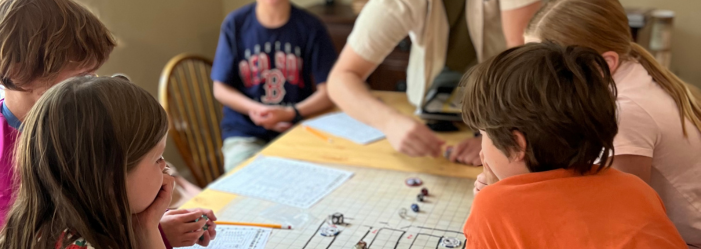The Grace and Courtesy of Thank You: Montessori Lessons in Gratitude
The Grace and Courtesy of Thank You: Montessori Lessons in Gratitude

“Grace” and “courtesy” might sound like old-fashioned words, but in a Montessori classroom, they are the quiet heartbeat of community life. Grace and courtesy lessons teach children not just good manners, but the deeper values of awareness, kindness, and gratitude. At Sandwich Montessori School, we see these lessons everywhere . . . in a child offering to help a friend tie a shoe, in the hush that settles when someone says, “excuse me,” and in the small but powerful act of saying “thank you” with sincerity.
These skills are not delivered as lectures or one-time lessons. They are lived every day and, when practiced with intention, grace and courtesy transform ordinary routines into opportunities for belonging, empathy, and joy.
What Are Grace and Courtesy in Montessori?
In Montessori education, grace and courtesy refer to simple, intentional ways of showing respect for oneself, others, and the environment. Grace is the quiet awareness we carry inside; courtesy is how that awareness shows up in action.
Maria Montessori wrote, “The child is both a hope and a promise for mankind.” Grace and courtesy help children fulfill that promise by teaching them how to live peacefully with others.
In our classrooms, a teacher may quietly demonstrate how to say “excuse me,” push in a chair, or greet a visitor. There’s no scolding, no spotlight, just calm modeling. Children watch, practice, and soon offer the same gestures themselves. Each small moment builds confidence and emotional intelligence.
Why Grace and Courtesy Matter
Grace and courtesy go far beyond politeness. They help children develop empathy, patience, and the ability to understand other perspectives. When children learn to listen, wait their turn, and consider how their actions affect others, they are building the foundation for healthy relationships and peaceful classrooms.
One morning in our
elementary room, two students both reached for the same, and last green marker in the holder. Instead of rushing to solve the problem, their teacher quietly waited. The pause gave them space to think. One child looked up and said, “You can have it first. I’ll start with another color.” It wasn’t a rehearsed response, it was self-control and kindness in motion.
Children crave order and belonging. Grace and courtesy meet those needs in ways that feel natural and empowering. They help students understand that respect is not demanded; it is created, moment by moment.
How Montessori Teachers Model Grace and Courtesy
Through Direct Demonstration
Montessori teachers don’t lecture about kindness, they model it. When a visitor enters the classroom, the teacher stands, smiles, and says, “Good morning, we’re glad you’re here.” Children watch and absorb every detail, from eye contact to tone. Soon, they’re the ones greeting guests with calm confidence.
Through Role-Play and Real-Life Practice
Children practice these lessons daily: offering a snack, asking politely for a turn, or inviting a classmate to work together. During a grace and courtesy lesson, the guide might say, “Let’s practice how to offer help if someone drops something.” The children act it out, giggling as they dramatize, then carry that learning into their real interactions.
Through Observation and Reflection
Guides model gentle voices and gratitude in their own behavior. When a child spills water, the teacher simply says, “Let’s get a cloth and clean it together.” There’s no blame, only partnership. Over time, children begin to mirror this calmness. As Montessori guides, we believe discipline grows through example, not correction.
Grace and Courtesy in the Montessori Classroom
From the moment children arrive, grace and courtesy shape the flow of the day. Morning greetings begin with handshakes and eye contact. During snack or lunch, students set the table, pour water, and offer food to friends before serving themselves. When disagreements happen, guides teach language for resolution: “I didn’t like that,” or “Can we try again?”
At group meetings, a small “peace stone” passes from hand to hand. Only the child holding it speaks while others listen. One morning, a young student held the stone and whispered, “Thank you for helping me with my work yesterday.” The class fell silent, not out of rule, but out of respect. It’s in these quiet moments that gratitude takes root.
Bringing Grace and Courtesy Home
Families often tell us they want to extend grace and courtesy into their homes. Here are a few simple ways to begin:
Model the Behavior You Want to See
Children absorb how we speak to others. Try gentle phrases like, “Let’s try that again kindly,” and say thank you often. Gratitude becomes part of your family’s rhythm.
Create Predictable Routines
A calm home environment supports respectful behavior. Rituals like greeting one another each morning, sharing meals, and saying goodnight mindfully give children a sense of belonging.
Encourage Real Participation
Invite children to take meaningful roles, setting the table, opening doors, or helping guests. When children contribute, they see themselves as capable and valued, deepening their sense of gratitude.
How Grace and Courtesy Foster Gratitude
Grace and courtesy are gratitude in motion. Grace helps children slow down and notice beauty. Courtesy gives them language to express appreciation.
One afternoon, a child accidentally spilled paint water across a table. Before the teacher could step in, another child was already there with a towel. The first smiled and said softly, “Thank you.” It was genuine, not prompted. Montessori teachers help children feel gratitude, not just say the words.
Maria Montessori once wrote, “Joy, feeling one’s own value, being appreciated and loved by others . . . are all factors of enormous value for the human soul.” In a Montessori environment, those experiences happen every day.
Why It Matters Long-Term
Children who grow up surrounded by grace and courtesy become adults who lead with empathy. They learn to listen deeply, speak kindly, and contribute to the world around them. Conflict turns into cooperation and gratitude becomes a habit.
These lessons ripple outward, shaping not just classrooms, but families and communities grounded in kindness.
The Grace and Gratitude Connection at Sandwich Montessori School
At Sandwich Montessori School, grace and courtesy are woven into everything we do. Children greet guides each morning, care for the environment, and practice gratitude during outdoor lessons as they notice the colors of fall or the first buds of spring. In mixed-age classrooms, older students model gentleness for younger ones, and gratitude naturally flows both ways.
Gratitude here is not a single word, it’s a rhythm that runs through the day, the tone of every interaction, and the quiet grace that fills a peaceful classroom.
Learn more about how we nurture kindness, independence, and gratitude at Sandwich Montessori School →
Here













